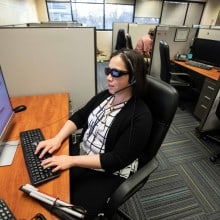Sandy’s View: Debunking Three Common Myths about Employees with Disabilities
October is National Disability Employment Awareness Month, a celebration recognizing the skillsets and talents employees with disabilities bring to the workplace. Although legislation such as the Americans with Disabilities Act (ADA) prohibits discrimination on the basis of disability, attitudinal barriers are still prevalent and hard to eliminate. As someone who is blind, I have heard countless misconceptions about hiring those of us with disabilities. Sadly, these ideas lead to false assumptions, and as a consequence a lack of employment for this community. In this post, I will debunk the top three myths that are still common among employers and in society at large.
Myth #1: Employees with disabilities cannot be expected to do the same tasks as their non-disabled peers.
Nothing can be further from the truth! Just like non-disabled employees, people with vision loss or other disabilities should be held to the same standards and expectations in the workplace. Remember that like everyone else, we applied and got the job because we had the skills and met the position requirements in the first place. Similarly, employees with disabilities should be given the same type of feedback or discipline like all other workers. If adequately provided with the accommodations and/or tools needed to do the job, we can and will be excellent employees!

Sandy works as an associate producer at the Chicago Lighthouse Media Center, where she manages the daily operations of CRIS Radio.
Myth #2: Employees with disabilities need extra help or constant supervision
Like all other employees, workers with disabilities will benefit from any instruction or training necessary to do the job, particularly during the first days or weeks. Individuals with vision loss might find a quick orientation around the building helpful so they can familiarize themselves with the location of places like restrooms, emergency exits, the cafeteria and so on. Some individuals, such as those with developmental disabilities, may benefit from receiving the services of a job coach or similar programs. Note that persons requiring this service will often obtain it even before applying or interviewing for a given position. As previously mentioned, when given the appropriate instruction and tools, employees with disabilities will be as independent and productive as the rest of the team.
Myth #3: Hiring people with disabilities is expensive because they require special equipment
More often than not, it costs very little or nothing to provide individuals with disabilities with workplace accommodations. Something as simple as rearranging furniture so that a person who uses a wheelchair can move around the office might be the only adjustment needed. People with other disabilities like visual impairments might need assistive technology to use a work computer. Even in the latter instance, there are vocational and rehabilitation services programs that can help offset costs. In addition, employers can apply for and receive certain tax credits to help cover these expenses.
This October, let’s take the time to create more awareness around the talents and contributions employees with disabilities bring to the workplace if given the chance. Just like our non-disabled colleagues, we are eager to be productive individuals and ultimately self-sufficient members of society. Sadly, a lot of misinformation still exists, and this prevents people with disabilities who are otherwise skilled and competent from getting a job.
What other myths have you heard regarding employees with disabilities? Please comment! You can also send an email to sandysview@chicagolighthouse.org. I invite you to share this post so that together we will debunk the misinformation and create a more inclusive workplace.





